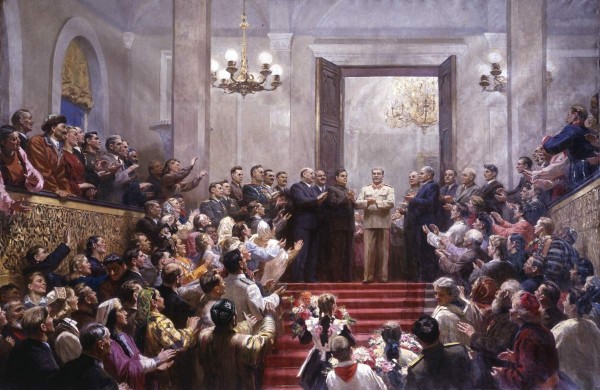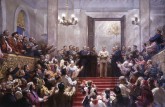Glory to the Great Stalin!
1950
The compositional and coloristic structure of the painting created by a team of authors (Yu. P. Kugach, V. K. Nechitailo, V. G. Tsyplakov) to the All-Union Art Exhibition of 1950, completely subordinated to the idea of presenting the leader of the state as the inspirer and organizer of the greatest victories. The grand staircase leading up, the hands of the applauding crowd, the open doors symbolizing a breakthrough into infinity, and the successfully staged lighting convey the jubilant mood of those present in the best possible way. Stalin appears in a shining halo, like a celestial descended to the crowd, close and inaccessible at the same time.
In the immediate environment of the leader are prominent members of the party and government (N. A. Bulganin, A. I. Mikoyan, A. A. Andreev, L. P. Beria, V. M. Molotov, A. N. Kosygin and others), famous military leaders and pilots (K. E. Voroshilov, I. N. Kozhedub, A. I. Pokryshkin), leaders production (A. G. Stakhanov), as well as prominent scientists — President of the USSR Academy of Sciences physicist S. I. Vavilov and Director of the Institute of Genetics of the USSR Academy of Sciences T. D. Lysenko. This "meeting" of academicians Vavilov and Lysenko (pictured on the left, behind the railing of the stairs) is one of the many paradoxes of Stalin's time. It is known that Sergey Vavilov's brother Nikolai, a prominent geneticist, founder and director of the Institute of Genetics, was arrested in 1940 with the help of Trofim Lysenko, who began the fight against classical genetics, and died in prison in 1943. Lysenko, after his arrest, headed the Institute and completed the destruction of genetics. Next on the canvas are representatives of numerous peoples inhabiting the Soviet Union, children and typical representatives of the masses. Thus, the ideologeme "man — crowd — leader" finds its canonical embodiment here. // Alice Lyubimova. Electronic catalog "Heroes and Villains of Russian History". St. Petersburg, 2010. p. 476.

